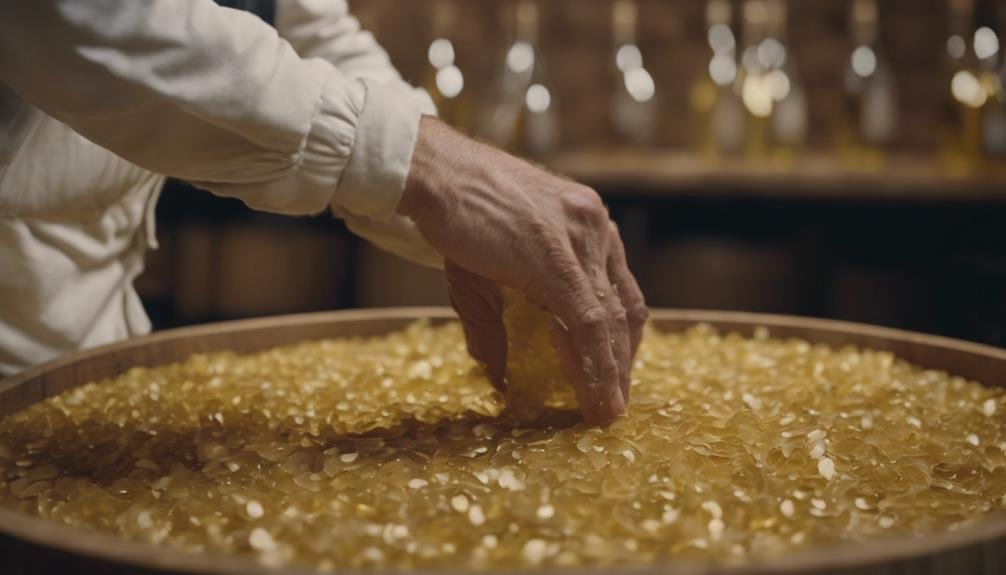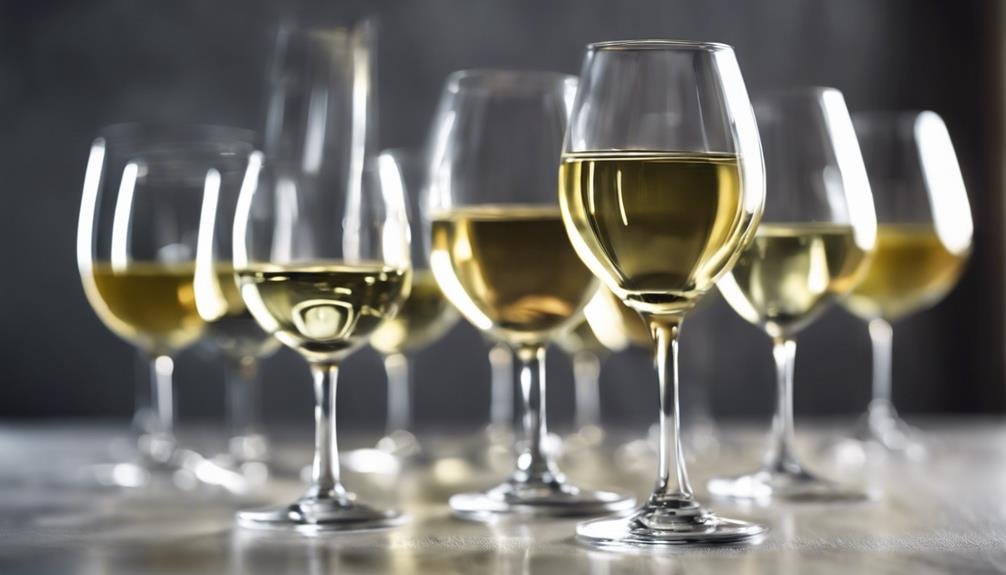White wine crafting involves precise grape harvesting, pressing, and fermentation techniques. Ripeness assessment impacts sugar levels, while pressing affects flavor purity. Harvest timing and cool temperatures preserve acidity and aromas. Post-extraction settling clarifies liquid. Sulfur dioxide prevents spoilage. Fermentation by yeast transforms sugars into alcohol, with different strains influencing flavors. Controlled fermentation temperatures maintain aromas. Lees stirring and oxygen exposure in secondary fermentation enhance texture and aroma. Stainless steel tanks and oak barrels aid in aging, each imparting unique flavors. White wines offer diverse profiles from crisp to creamy, pairing well with various dishes. Understanding these processes reveals the art of crafting white wines.
Grape Harvest and Processing Techniques
When crafting white wine, the grape harvest and processing techniques play a pivotal role in determining the final flavor and quality of the wine. Ripeness assessment is vital in ensuring ideal sugar levels for fermentation, impacting the wine's sweetness and balance.
Juice extraction, through pressing, is a delicate process that influences the purity of flavors in the wine. The timing of the harvest, along with cool temperatures during grape picking, is essential to preserve the grape's natural acidity and aromatic compounds.
Settling the juice post-extraction helps remove bitter solids and clarify the liquid before fermentation. Sulfur dioxide is often added at this stage to prevent spoilage and maintain the wine's freshness.
These meticulous steps in grape harvesting and processing set the foundation for creating exceptional white wines.
Fermentation Process Insights
The fermentation process in white wine making is an essential stage where yeast transforms sugars into alcohol, playing a significant role in the wine's final characteristics.
Yeast selection is a pivotal decision that influences the flavors and aromas of the wine. Different strains of yeast can result in variations in the final product, offering winemakers a spectrum of options to choose from based on the desired outcome.
Temperature control during fermentation is also key, as white wines typically ferment at cooler temperatures compared to red wines. This control allows for the preservation of delicate aromas and flavors in white wines.
Secondary Fermentation and Finishing Methods

In white wine crafting, the secondary fermentation and finishing methods play a crucial role in enhancing the complexity and quality of the final product. Lees stirring, a technique where the sediment from the yeast is stirred back into the wine, contributes to a richer texture and more nuanced flavors. Controlled oxygen exposure during the aging process can benefit white wines by helping to soften harsh tannins and develop desirable aromas. To illustrate the importance of these methods further, consider the table below:
| Techniques | Description | Benefits |
|---|---|---|
| Lees stirring | Stirring sediment into wine for richness | Enhances texture and flavor |
| Oxygen exposure | Controlled exposure during aging process | Softens tannins, develops aromas |
Aging and Maturation Approaches
Utilizing various vessels such as stainless steel tanks and oak barrels, white wines undergo distinct aging and maturation processes contributing to their final flavor profiles.
Barrel maturation imparts flavors like vanilla, spice, and toast, enhancing complexity and richness. Stainless steel aging, on the other hand, preserves the wine's fresh fruit characteristics with minimal influence from the vessel.
The choice between these methods depends on the winemaker's desired style and the grape varietal. Aging duration can vary from a few months to several years, during which lees stirring may be employed to add depth and mouthfeel.
Maturation plays an important role in shaping the flavor profile and texture of white wines before bottling for eventual consumption.
White Wine Styles and Characteristics

Exploring a spectrum of styles and characteristics, white wines offer a diverse range of aromas and flavors suited for various palates and occasions. The flavor profiles of white wines can range from crisp and citrusy to creamy and oaky, with importance playing a vital role in balancing these elements.
White wines are commonly categorized into styles such as dry, off-dry, sweet, and sparkling, each offering unique sensory experiences. When serving white wine, it is recommended to chill it appropriately and use suitable glassware to enhance the tasting experience.
White wines pair well with a variety of foods, including seafood, poultry, salads, and creamy dishes, making them versatile options for different dining occasions.
Frequently Asked Questions
How Does the Choice of Yeast Impact the Flavor of White Wine?
Yeast selection in white wine crafting greatly influences the flavor profile. Fermentation in oak barrels imparts vanilla and spice notes, while stainless steel vessels maintain fruitiness. Acidity levels, influenced by aging vessels, impact the wine's aging potential and overall character.
What Are the Effects of Different Aging Vessels on White Wine?
The vessel in which white wine ages profoundly influences its character. Oak barrels impart rich flavors and textures, while stainless steel tanks maintain freshness. Concrete eggs and clay amphorae add complexity. Each vessel shapes the wine uniquely.
Can White Wine Undergo Aging Without Lees Stirring?
White wine can undergo aging without lees stirring; however, it may lack the added complexity and texture that lees stirring provides. Temperature control during aging is essential to prevent oxidation and maintain the wine's quality.
Why Is Malolactic Fermentation Optional in White Wine Production?
Malolactic fermentation is optional in white wine production to preserve acidity and freshness. This process can stabilize wine, impacting aroma profile. Yeast selection and stability are essential. Understanding this choice enhances winemaking decisions and final product quality.
How Does Acidity in White Wine Influence Its Aging Potential?
Acidity balance in white wine greatly influences its aging potential. It acts as a preservative, impacting the wine's structure, complexity, and ability to evolve over time. Grape selection plays an essential role in determining the initial acidity levels for aging considerations.
Conclusion
In the intricate world of white wine crafting, each step from grape harvest to aging plays a pivotal role in shaping the final product.
Just as an artist carefully selects their palette and brushstrokes, winemakers meticulously choose grapes and fermentation techniques to create a symphony of flavors in every bottle.
The artistry behind white wine crafting is a harmonious blend of tradition and innovation, resulting in a sensory experience that tantalizes the taste buds and delights the soul.